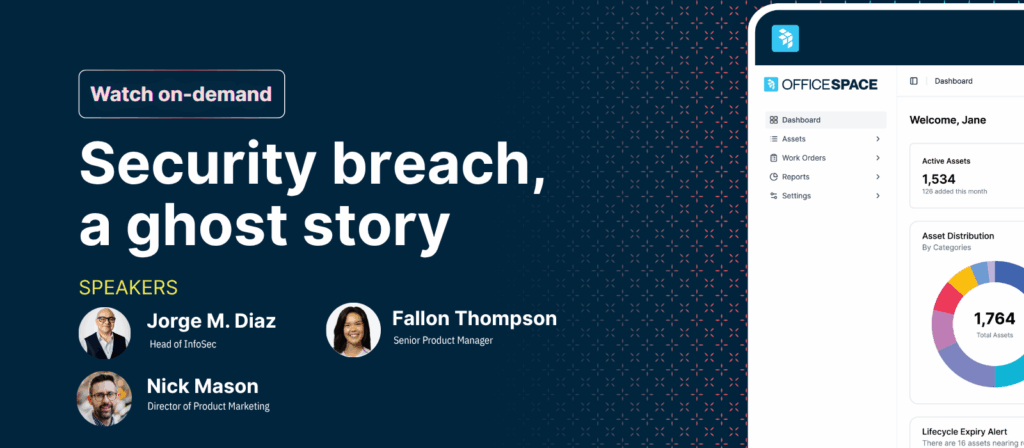 In this Workplace Unplugged interview, we find out what it takes to prepare a software company for an IPO, the importance of strategic partnerships and how FM’s and HR can work better together.
In this Workplace Unplugged interview, we find out what it takes to prepare a software company for an IPO, the importance of strategic partnerships and how FM’s and HR can work better together.
Paul Martin, Manager of Business Development at Namely, has cut his teeth in the world of SaaS. To start off, we asked Paul to tell us about his background and what led him to his current role at Namely.
PM: I’m a partnerships guy by trade, with experience working at a few different SaaS companies. Before Namely, I was at a company called Cvent for a few years pre-IPO and a few years post-IPO, building out our partner ecosystem. I got great experience there building a company up from a smaller headcount, lower recurring revenue, all the way up to a successful SaaS IPO. Then it was a great experience to be a publicly traded company, answering to the street, so to speak, and making sure that all of the metrics that we worked all those years to build up were maintained.
Two years ago I made the transition to a smaller company here at Namely, where we’re again on our way to an IPO – hopefully over the next few years is the goal. What I’ve been able to do is build, from the ground up, our partner ecosystem. I think it’s a really important strategy for Saas companies–software does not operate in a vacuum. Really no matter the industry it’s important to have some kind of free flow of data with other software utilized in the tech-stack of your customers. So, building up an ecosystem of connected technology is invaluable to the sales process, acquiring new clients, and in keeping our current clients happy. Growing companies in particular are constantly looking for ways to get more out of their resources and obviously in software that’s kind of the name of the game. If you can make all of these different pieces of software interact with one another and have the data integrated across all of the different platforms, then it’s going to make your end user and your clients lives easier.
Namely is used in over 30 countries and has raised over $150M in funding from Sequoia Capital, Matrix Partners, Altimeter Capital, True Ventures, and others. Paul tells us why Namely stands out from it’s competitors.
PM: We’ve been around as a company for about 5 years, we just celebrated 5 years this past January, and what we provide is an all in one HCM platform for growing, mid-market companies. From a product perspective, we provide HR, time management, payroll and benefits software. In terms of our target market, we’re working with midmarket businesses that range anywhere from 25 employees all the way up to a few thousand. What we’ve found is that in our space there are point solutions and budget solutions that are great fits for small businesses, and then there’s a lot of great enterprise players that have brand recognition as products for Fortune 500 companies. This has created a vacuum in the midmarket space for companies that have gone through the difficulties of growing from 2 to 5 to 20 employees. They’re starting to focus on building out their internal HR function and HR strategy, and Namely is the platform that will empower them to continue to grow to 100, 200 employees and beyond.
Our big differentiator is the idea of empowering and engaging employees. From an admin perspective, Namely really has all the power under the hood, so to speak, for an HR admin to live and breathe in the platform every day. However, we’re asking: what if we empowered the employee to utilize Namely, adopt a more self-service mantra, and engage Namely on a more frequent basis? Whether it’s going and posting things on the feed, whether it’s appreciating their coworkers achievements, or something more utilitarian like managing their time off and things like that. The more that we can get employees using Namely, the more empowered that employee then feels, and it goes a long way towards building a culture of engaged employees. Plus there’s just more data within the system that the HR function can utilize to inform their decisions and focus on strategy, rather than just the daily admin.
Paul walked us through a day in his role as Manager of Business Development at Namely.
PM: I think what’s so great about it is that (everybody says this, but it’s really true) every day is totally different. Strategic partnerships is a function that really touches on all of the different departments here at Namely and because of that there’s a ton of things that can happen on a daily basis. First, I’m responsible for finding new partners that we could engage with, whether they’re software or other technology providers, so I do a ton of industry research, a ton of networking just to find out what is out there in our space. Second, I manage our current partner relationships, and work with partners on things like enhancing our shared go-to-market strategy. Then, I could be working with clients utilising our partner products or services, if they have questions, or if they are interested in best practices. The thing that’s really great is that I work with a team of subject matter experts across the company. I’m certainly not an engineer, I’m certainly not a direct Namely support resource, but I’m lucky to be able to bring in my colleagues who are total experts and rockstars in their roles. I’ll work with our engineering team on a current integration build, I could be working with our product management team on our partner roadmap, or I could be working with a lead in client success to support our clients. I’m kind of a Jack of All Trades, but a Master of None in collaboration with a ton of people who are intelligent and gifted in various functions.
Having honed his skills in building strategic partnerships, we asked Paul to share how he keeps up to date on his industry knowledge and if he had any tools he could recommend to others.
PM: I don’t necessarily have true tools I utilize. I think the most important thing for me is being open to taking any conversation no matter how small, how tangential, or -to be very frank- how unrelated it might seem to our own strategy here at Namely. Whether you’re working for a software company or service provider, whether you’re an HR admin at a company, whether you’re a consultant, I’ve found that partnerships are interesting because there’s always a way that you can spin it so that two companies can work together. Really what I find is that it’s not a yes/no, it’s more about how strong the synergy is (to use a horrible business buzzword, but it’s really applicable here). Taking the call and having every conversation is really important because it might not move the needle in a big way, or even a small way, but there’s something that you can learn from a company that might seem very disconnected from the world that you work in. I’ve had so many conversations where going into it I thought ‘this is going to be a five minute conversation and we’ll be out the door’, but the next thing I know an hour later my eyes have been opened up, and while there might not be something I can work on right now, it’s got me thinking of ways that I can get to that point. So, take every conversation and always be open.
For Namely, it’s also important to speak with our current clients. When it comes to our partner strategy it’s crucial to get an idea of what’s happening out in the overall market and to find out what our clients’ technology stack looks like, find out what other service providers they work with, find out what is and isn’t working within their HR functions. That really goes a long way for our overall partnership strategy.

The biggest mistakes that HR managers make? Not empowering their employees with their HR software.
PM: One of the things that we really open our client’s eyes to is the value of engaging employees and focusing on the employee experience in the HR platform. The old school mantra might be, ‘I’m an HR admin, HR generalist, Head of People, and I want to make sure that my HR function is going to be able to utilize the platform’. What we’ve found, however, is that an equally important perspective is, ‘how are the employees using the product?’. If you can push that employee self-service model, selfishly, it’s better for the HR team because they’re going to have more time and resources to devote to strategic initiatives. Also, when you empower your employees – this idea that employees are your most important asset – you create a culture of engagement across the company. It’s invaluable when it comes to keeping up employee satisfaction and morale. Especially for us in software evaluations that we’re constantly supporting companies during, it’s not just about what the HR team is going to use, it’s about what the entire employee base is going to use.
To meet the needs of new working practices, HR and facilities managers need to start working together. We asked Paul to share a few tips for how HR and FMs can work better together.
PM: Having some kind of a direct organizational alignment between those teams is really important. I find that facilities management will often fall under the HR umbrella, or both HR and facilities management will fall under the same umbrella – maybe it’s under finance or operations. Just having clear alignment between those teams and making sure that they’re not siphoned or siloed off is the most important thing. At the end of the day, operationally speaking, there is a ton of overlap there between HR, operations, and facilities management so fundamental alignment is key.
The integration between Namely and OfficeSpace is an example of software supporting this idea. Namely’s HRIS houses employee profile information and org charts, while OfficeSpace handles office layout and seating charts. With our new integration, Namely employee data is pulled directly into OfficeSpace to populate an organization’s seating charts. Aligning our products connects HR and Facilities Management functions, making both team’s lives simpler.
What does Paul foresee as being the biggest influence or change in the world of software technology in the next five to ten years? Building the right ecosystems of connected products.
PM: In the next five to ten years, I think it’s this idea of building up an ecosystem of connected products. There are two strategies that companies can have here. One, adopt an all-in-one platform that does everything under the sun but does everything kind of O.K.–it’s almost all MVP’s (minimum viable products). Everything is under one roof so it’s easier, theoretically, to implement and to manage because there’s one product and one organization that you’re interfacing with; however, it’s a “one size fits all” dilemma, with little flexibility. The other strategy is to have a best-in-class solution in each product category – in HR software maybe it’s the best learning management system, best payroll provider, best HRIS, best recruiting solution – creating this huge technology stack that a company would utilize. The benefit here is that you’re using all of the best products and you’re able to choose from a menu in each of those categories to make sure that they all meet your needs. The negative is that you’ve got countless products that you then have to implement, learn, and manage. In my opinion, I think splitting the difference is going to be the best strategy. A company should say ’how can we work with a best-in-class platform that really covers our core functionality needs?’. In the case of Namely, a good example would be our HR, payroll and benefits platform, that also connects to more complementary or ancillary products. So, building a strategy that isn’t totally platform based, where one system does everything, but also isn’t too decentralized where there’s point solutions for everything.

In conclusion to our chat, we asked Paul to share what he sees as the most challenging part of his day-to-day.
PM: It’s a challenge, but it’s also what makes it so fun. The HR technology space is so rich with products and services, it seems like there’s a new solution that pops up every day, a new product ‘category’, or a new cutting-edge concept that we find in our client base. So, sometimes it can be really difficult to stay in front of it, to have an idea of all these different solutions that are out there, and how they influence the HR function. I think that’s my biggest challenge–staying in touch with the bleeding edge of our space. But it’s also what makes a role like this so important. Because there are so many solutions, and because every day the space is evolving, it means that there are always new opportunities for Namely to collaborate. It’s kind of a gift and a curse for me personally, but I love it.
To get in touch with Paul, you can send him an email at [email protected] or connect with him on LinkedIn.
How connected are HR and Facilities at your organization? Let us know in the comments below.
Photos: Breather, Startup Stock Photos, Jessica Ruscello





